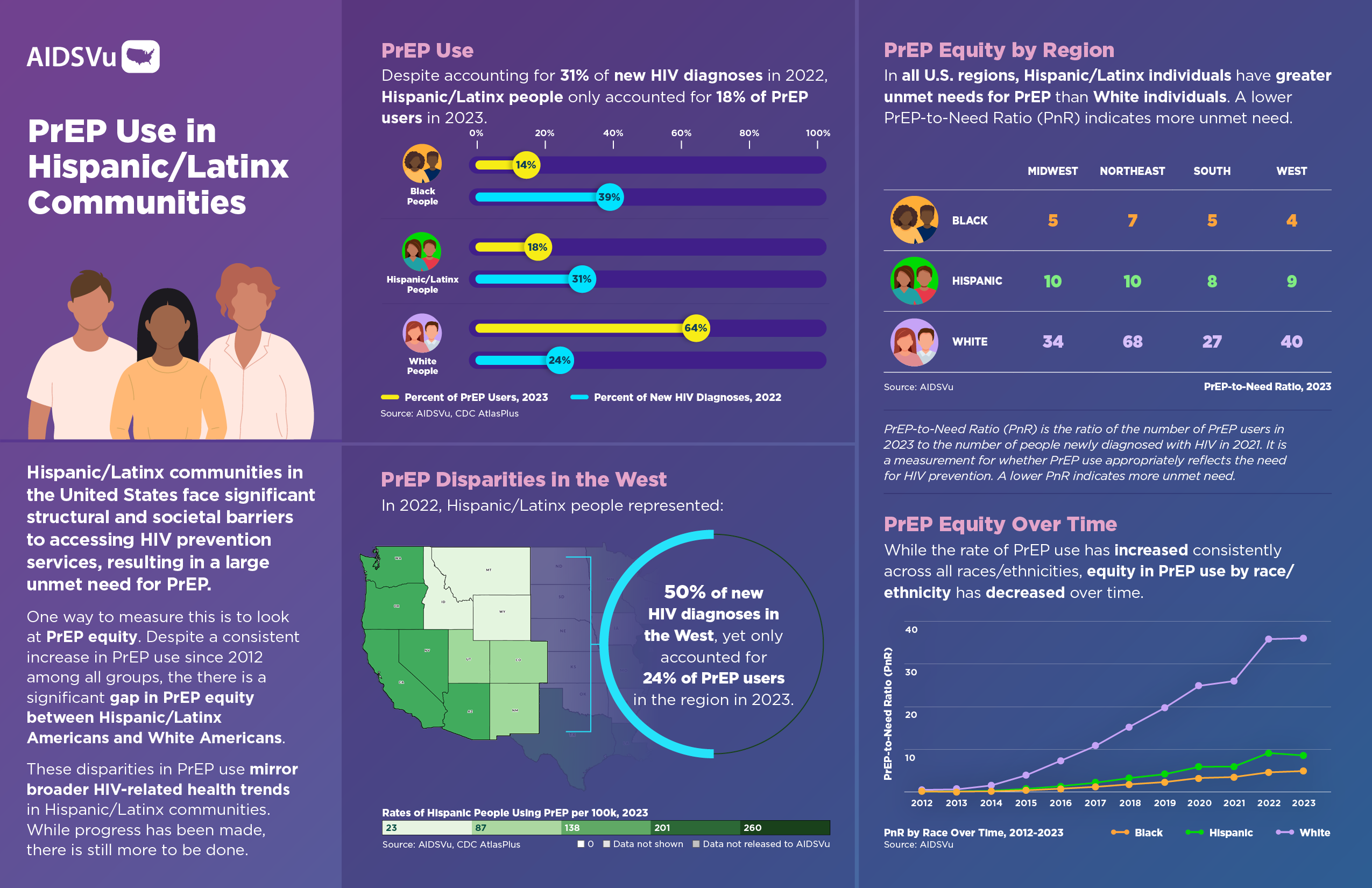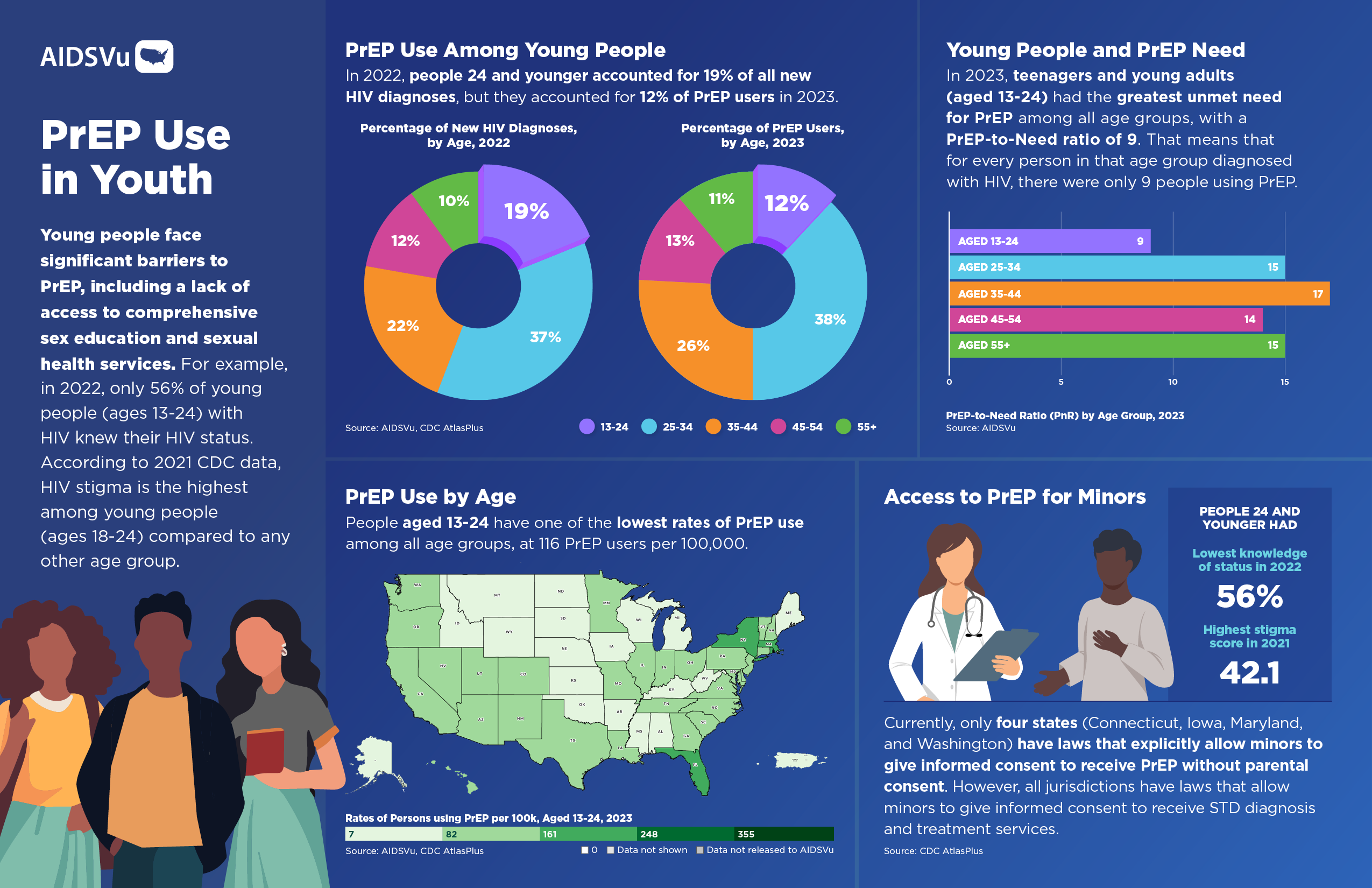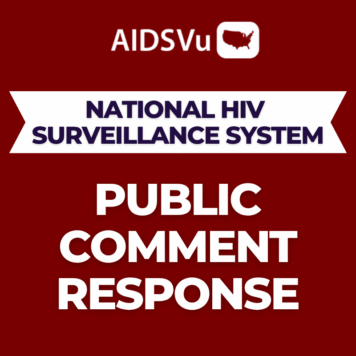AIDSVu has released 2023 PrEP use data on maps and location profiles , showing that while PrEP use has increased nationally by 17% from 2022 to 2023, regional and racial/ethnic inequities still exist, with greater unmet need for PrEP in Black, Hispanic/Latinx and Southern communities. These data underscore the importance of focusing PrEP programs and monitoring metrics on PrEP equity to prioritize communities with the greatest unmet need for PrEP.
AIDSVu provides the most recent and updated data on PrEP use and the PrEP-to-Need Ratio (PnR)—the ratio of the number of PrEP users to the number of people newly diagnosed with HIV– at the county and state-level by age, sex and race/ethnicity (state only). These data inform programs and policies to ensure that communities that are disproportionately impacted by HIV are aware of and able to access PrEP.
PrEP, or pre-exposure prophylaxis, reduces an individual’s chances of getting HIV. According to the CDC, PrEP reduces the risk of getting HIV from sex by about 99% and reduces the risk of getting HIV from injection drug use by at least 74%.
Welcome to PrEPVu
This year, AIDSVu is launching PrEPVu , a new platform to understand PrEP use and equity in communities across the United States.
Through data incubation, analysis and visualization, PrEPVu offers an understanding of PrEP use across the country and the inequities that exist for the people and communities with the greatest unmet need for PrEP. Powered by AIDSVu, PrEPVu offers insights from data, research, and experts to promote data-driven public health policy and action.
PrEPVu Monthly
To further the conversation on PrEP equity, PrEPVu is publishing PrEPVu Monthly, a newsletter on the latest PrEP research, expert commentary, and important policy and community updates. Sign up here today.
2023 PrEP Takeaways:
AIDSVu’s latest PrEP and PrEP-to-Need Ratio (PNR) data encompass trends from 2012 through 2023 down to the county-level, stratified by age and sex. At the state level, data can also be stratified by race/ethnicity. Key findings include:
(PrEP use data is from 2023, and new HIV diagnoses data is from 2022, unless otherwise noted.)
Overall PrEP Use:
- The number of PrEP users in the U.S. increased by 17% from 2022 to 2023, continuing a trend of consistent growth in PrEP use since 2012.
- Nationally, there are 14 PrEP users for every new HIV diagnosis. The PrEP-to-Need Ratio (PnR) has steadily increased from 10 in 2021, to 12 in 2022, to 14 in 2023.
- The South accounted for 53% of HIV diagnoses but only accounted for 39% of PrEP users. The South has the greatest unmet need for PrEP of all regions.
PrEP Use by Race/Ethnicity:
- Black people represent 39% of all new HIV diagnoses, but only accounted for 14% of PrEP users.
- Hispanic/Latinx people represent 31% of all new HIV diagnoses, but only accounted for 18% of PrEP users.
- White people represent 24% of all new HIV diagnoses but accounted for 64% of PrEP users.
- There is a greater unmet need for PrEP in Black and Hispanic/Latinx communities than White communities in all regions of the U.S.
- Regionally, Black people made up 48% of new HIV diagnoses in the South in 2022, but only 22% of PrEP users in the South in 2023; in the Midwest, Black people made up 42% of new HIV diagnoses in 2022, but only 13% of PrEP users in 2023.
- In the South, there were 27 white PrEP users for every new HIV diagnosis among white people. In comparison, there were only 5 Black PrEP users for every new HIV diagnosis among Black people.
- In the West, Hispanic/Latinx people represented 50% of new HIV diagnoses but only represented 24% of all PrEP users.
PrEP Use by Age:
- 64% of all PrEP users in 2023 were between ages 25 and 44 years old.
- Teenagers and young adults (aged 13-24 years) had the greatest unmet need for PrEP among all age groups, with a PnR of 9. That means that for every person in that age group diagnosed with HIV, there were only 9 people using PrEP. People aged 35 to 44 had the highest PnR of 17.
PrEP Use by Sex:
- Among all PrEP users in the U.S., 92% were male and only 8% were female, despite the fact that women comprised 19% of new HIV diagnoses.
- Males have a PNR that is more than two times higher than the PNRs for females, demonstrating that males have a lower unmet need for PrEP.
PrEP Use and Medicaid Expansion:
- In 2023, states that had expanded Medicaid had an average PrEP use rate that was 1.3 times higher compared with states that had not expand Medicaid.
- In 2023, states that had expanded Medicaid had an average PnRthat was almost twice as high compared to states that had not expanded Medicaid.
- Note: 41 of the 50 US states + D.C. had adopted and implemented Medicaid expansion as of December 2023.
*Note: The PrEP-to-Need Ratio (PnR)—the ratio of the number of PrEP users to the number of people newly diagnosed with HIV—serves as a measurement for whether PrEP use appropriately reflects the need for HIV prevention in a geographic region or demographic subgroup. A lower PNR indicates more unmet need for PrEP.
More PrEP Data & Resources on AIDSVu
Additional PrEP resources on AIDSVu include a Deeper Look: PrEP page providing further insights on AIDSVu’s PrEP use and PnR data, downloadable infographics and data sets, national, regional, state, county, and city profiles, and blogs by HIV experts. AIDSVu also features a PrEP Locator, a national directory of public and private practice providers of PrEP across the U.S. AIDSVu users can find local PrEP providers near them with this tool or overlay service locations on top of AIDSVu’s PrEP use maps.
About the Data
The release of the PrEP use data on AIDSVu was made possible through a data-sharing agreement, in which data were obtained from IQVIA with the support of Gilead Sciences, Inc., and compiled by researchers at the Rollins School of Public Health at Emory University.
IQVIA provides Emory a limited dataset of aggregated and anonymized pre-exposure prophylaxis (PrEP) data, along with age, sex, and race/ethnicity classifications. The IQVIA database contains anonymized individual-level prescription records collected electronically from US retail pharmacies, traditional pharmacies, specialty mail-order pharmacies, long-term care (LTC) facilities, and “other” pharmacies (e.g., in-hospital pharmacies, HMO pharmacies). The IQVIA database uses national estimates of prescription fills to estimate PrEP prescriptions for the small percentage of US prescriptions that are not tracked directly by IQVIA. The prescriptions database includes age and sex and was linked to a claims database to obtain diagnoses codes. Race/ethnicity was provided through a consumer database of self-reported information. Race/ethnicity data were available for about a third of PrEP users, and data summarized by race/ethnicity are based on that subset of users.
An algorithm was used to differentiate the HIV treatment and HIV PrEP indications using prescription and diagnoses data for individuals taking FTC/TDF, FTC/TAF after its approval in 2019, or cabotegravir after its approval in 2021. For AIDSVu, the analyses determined total PrEP usage with FTC/TDF, FTC/TAF, and cabotegravir and not individually for each product. IQVIA excluded prescriptions for TDF/FTC, TAF/FTC, and cabotegravir that were made for other known indications, such as, post-exposure prophylaxis (PEP), chronic hepatitis B management, and treatment for HIV and other opportunistic infections. An individual with diagnosis or treatment codes for HIV, chronic Hepatis B or codes for PEP prior to the exposure era of FTC/TDF, FTC/TAF, or cabotegravir would be considered not to be taking PrEP. Additional details can be found in the Technical Notes.
IQVIA shared aggregate datasets at the state- and county-level with Emory researchers. To account for underestimations of PrEP use due to misclassified prescriptions, the county-level PrEP users’ data were upweighted by using state-specific percentages of unclassified prescriptions (prescriptions that have an unknown indication). The method was adopted from Sullivan et al.’s published article in Annals of Epidemiology titled “Methods for county-level estimation of pre-exposure prophylaxis coverage and application to the U.S. ending the HIV epidemic jurisdictions.” The unrounded number of weighted PrEP users per county were then summed to obtain state-, regional-, and national-level estimates. Finally, Emory applied data suppression rules and developed the publicly available maps and data sets for AIDSVu. AIDSVu provides downloadable PrEP maps and datasets at the county-and state-level and PrEP datasets at the regional and national-level for researchers and health departments to utilize in their own analyses.
PrEP data are displayed as number of PrEP users and rates. Rates of PrEP use were calculated per 100,000 population to permit data standardization and comparison. Vintage county population estimates from the U.S. Census Bureau (2012 to 2022) were used for the denominators for yearly state-level data and yearly county-level data. PrEP rates for a given year were calculated using the corresponding year of the Vintage data. For example, Vintage 2012 population estimates were used to calculate 2012 PrEP rates, Vintage 2013 population estimates were used to calculate 2013 PrEP rates, and so forth. Vintage 2022 population estimates were used to calculate 2023 PrEP rates as they were the most current available.
Denominator totals overall, by age, by sex, and by race were for ages 13+. The 13+ totals were obtained from the Vintage data by taking the 10-14 age grouping and multiplying by 2/5ths to estimate 13-14-year-olds and then adding with all the other age groups. The denominator totals for the ≤24 age grouping was developed by combining 13-14 (again obtained by multiplying the 10-14 age grouping by 2/5ths), 15-19 and 20-24, to create one age category of 24 or less.
The PnR data compare the ratio of the number of PrEP users from 2012-2023 to the number of people newly diagnosed with HIV in each corresponding year. The numerator is number of PrEP users, by year, and the denominator is new HIV diagnoses cases, by year. Since 2021 new diagnoses is the latest year available on AIDSVu, it is used to calculate 2022 and 2023 PnR. As the HIV diagnoses data becomes available, the 2022 and 2023 PnR will be updated with future data launches.
The statements, findings, conclusions, views, and opinions contained and expressed on the AIDSVu website are based in part on data obtained under license from the following information service(s): LAAD Longitudinal Access and Adjudication Dataset HIV data, January 2012 – December 2023), IQVIA Inc. All Rights Reserved. The statements, findings, conclusions, views, and opinions contained and expressed herein are not necessarily those of IQVIA Inc. or any of its affiliated or subsidiary entities. Any analysis is independently arrived at by Emory University, on the basis of the data and other information.








